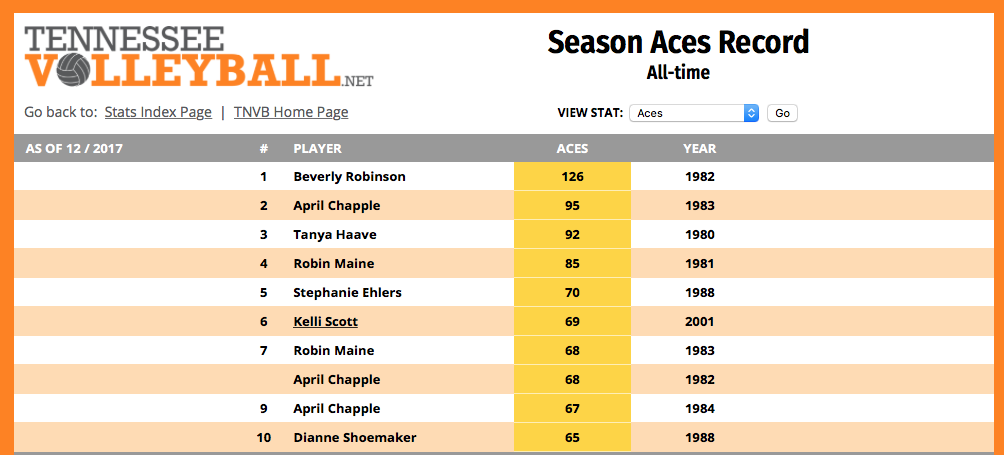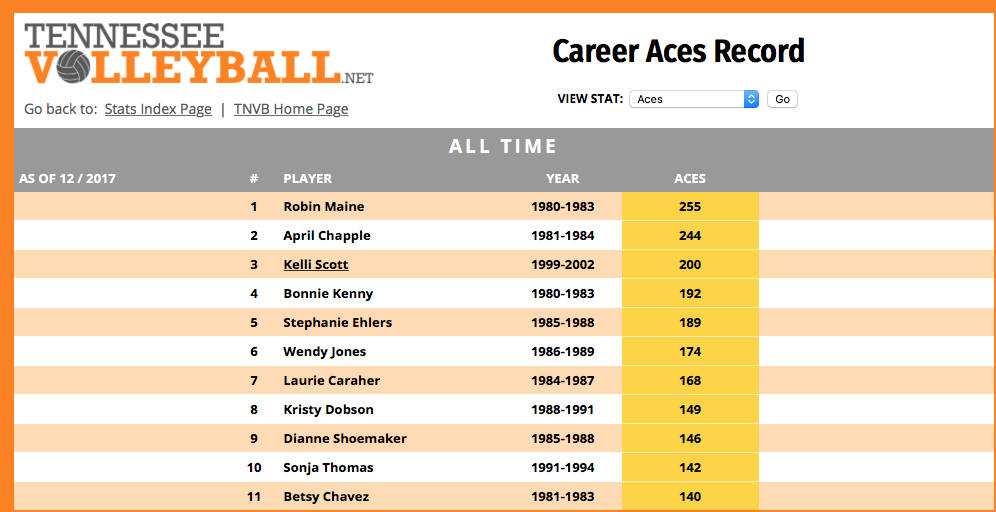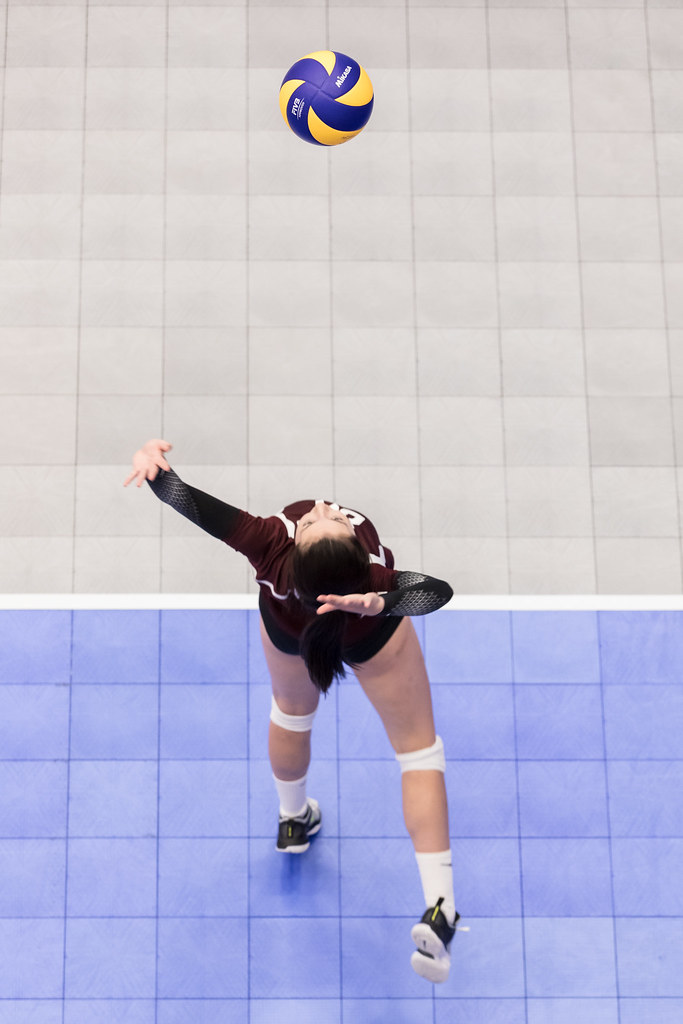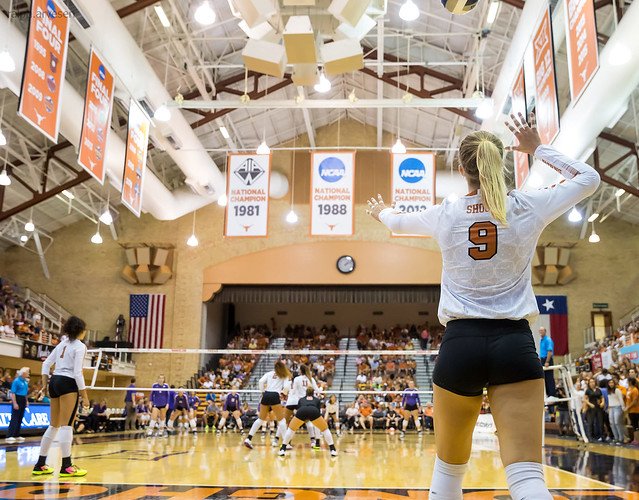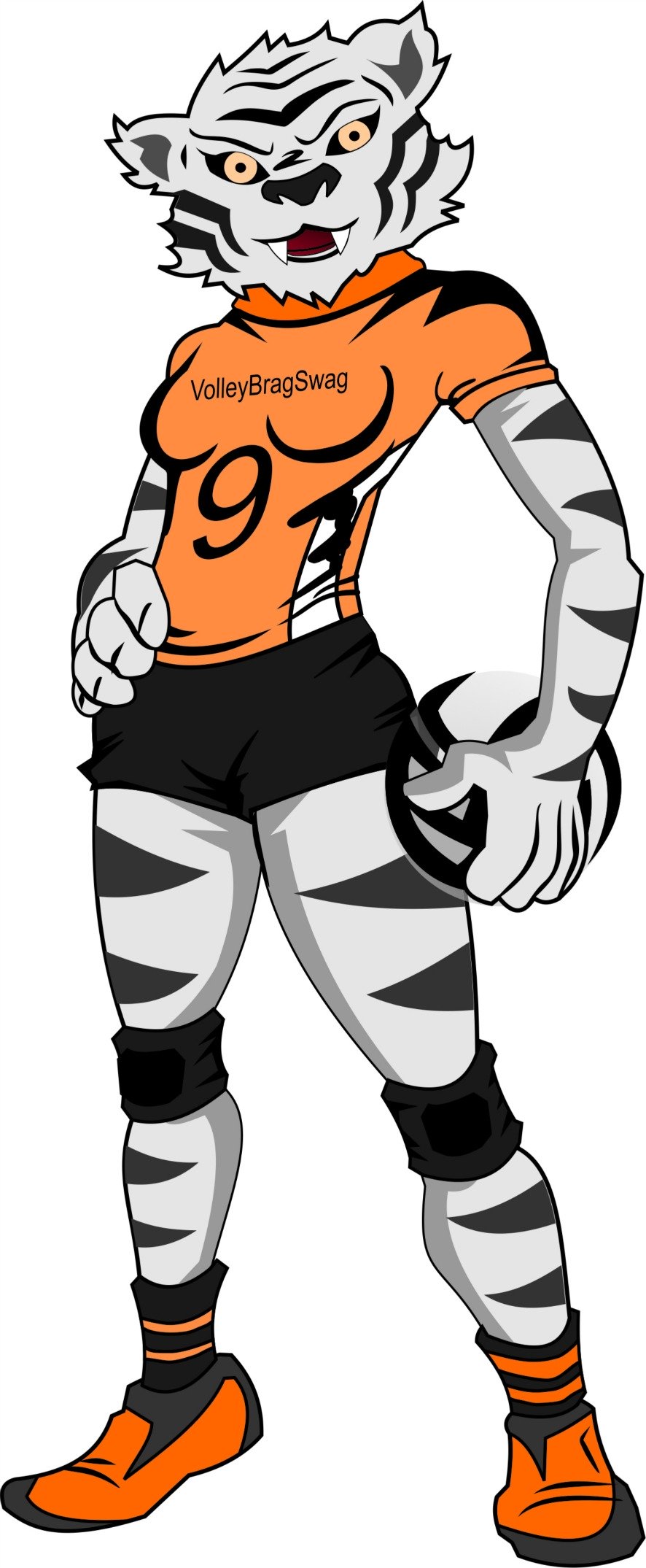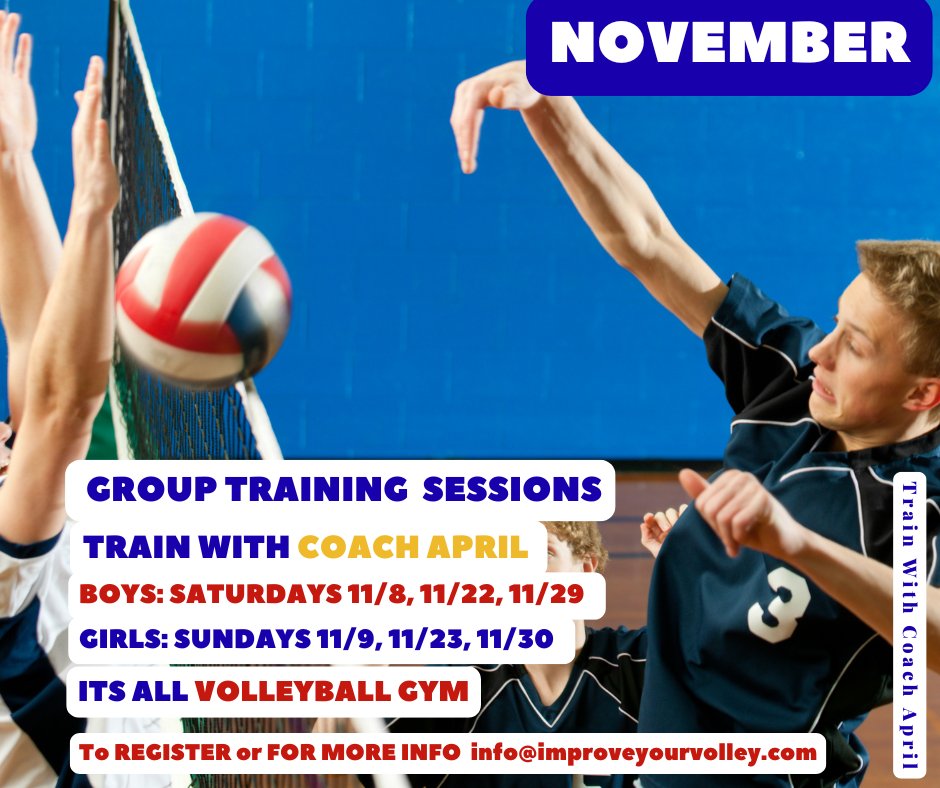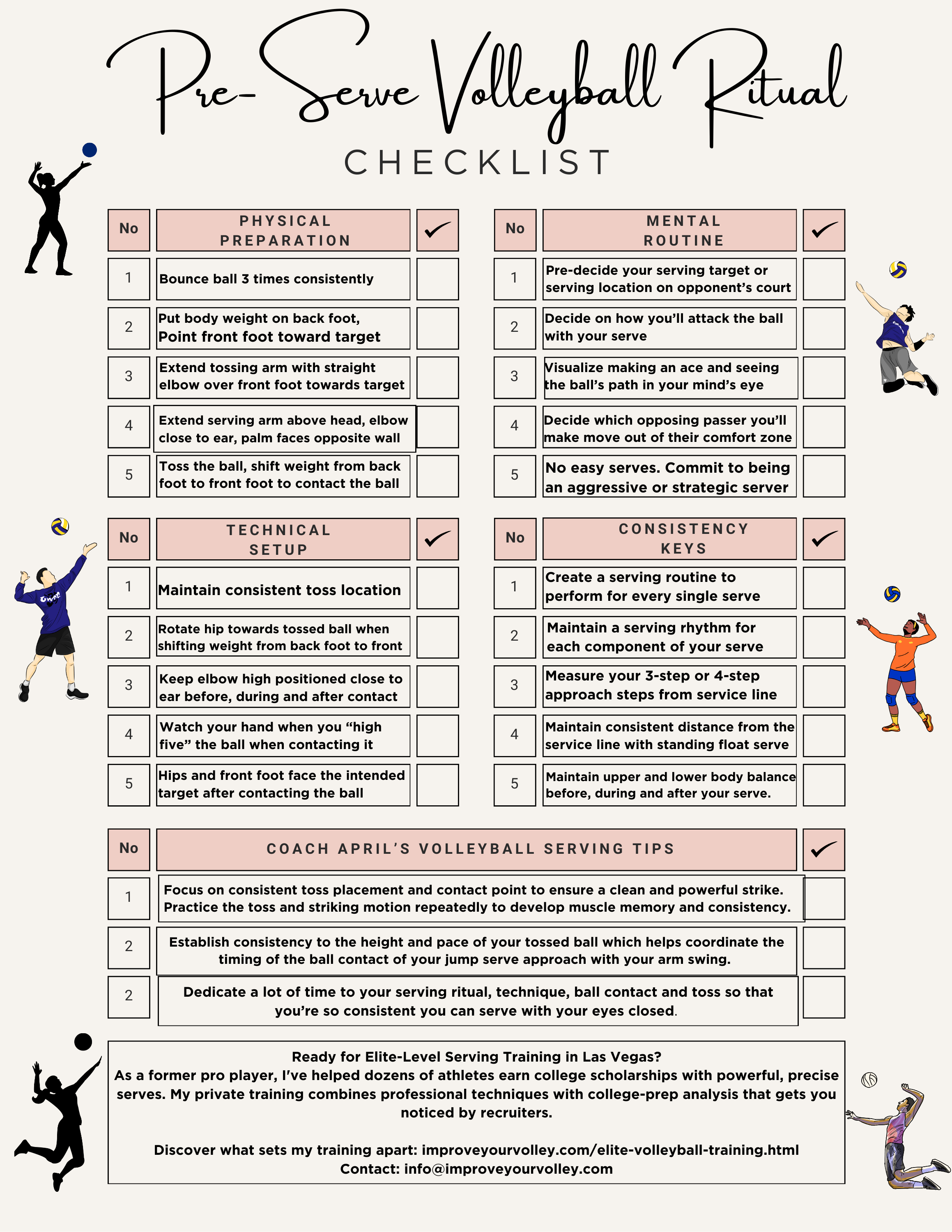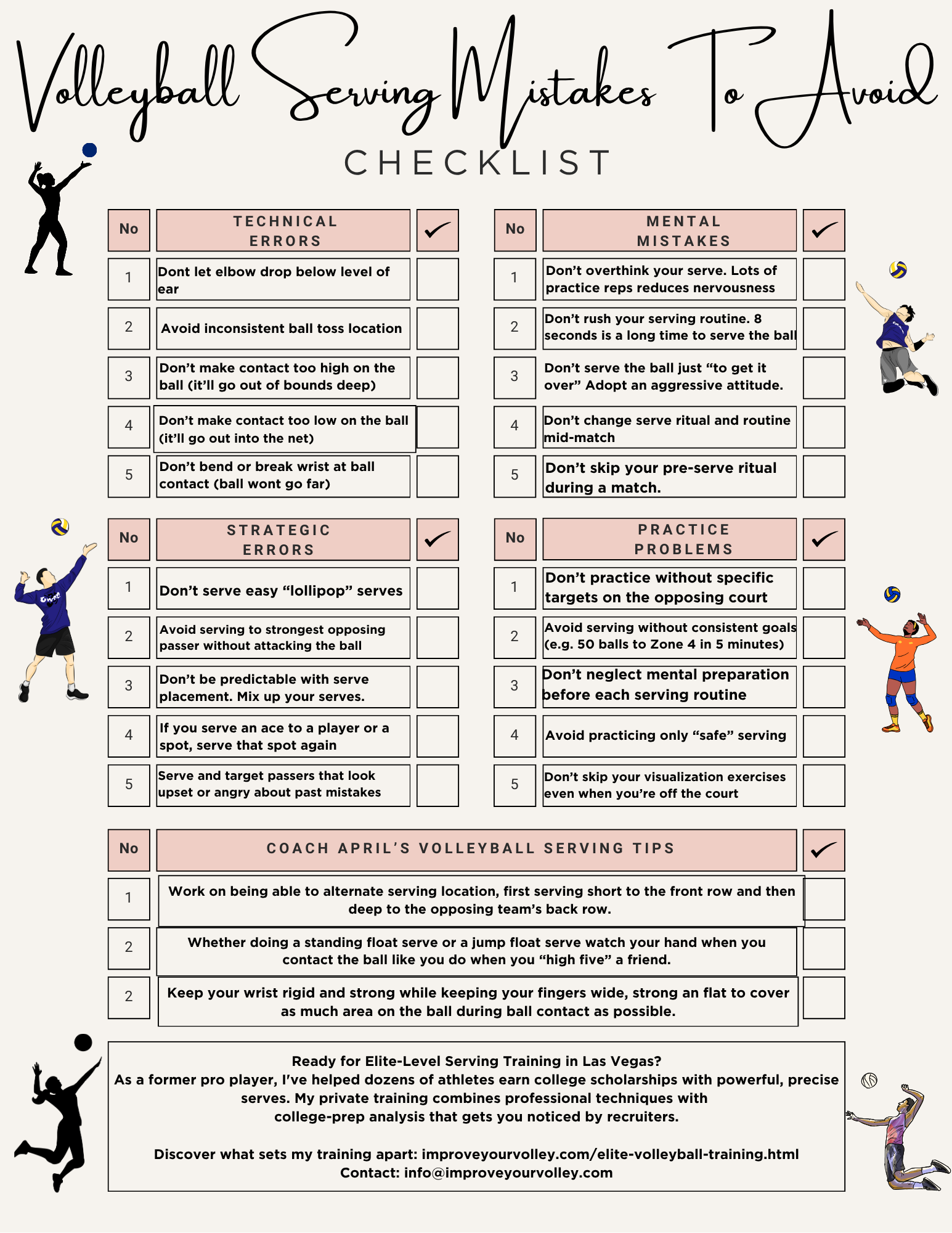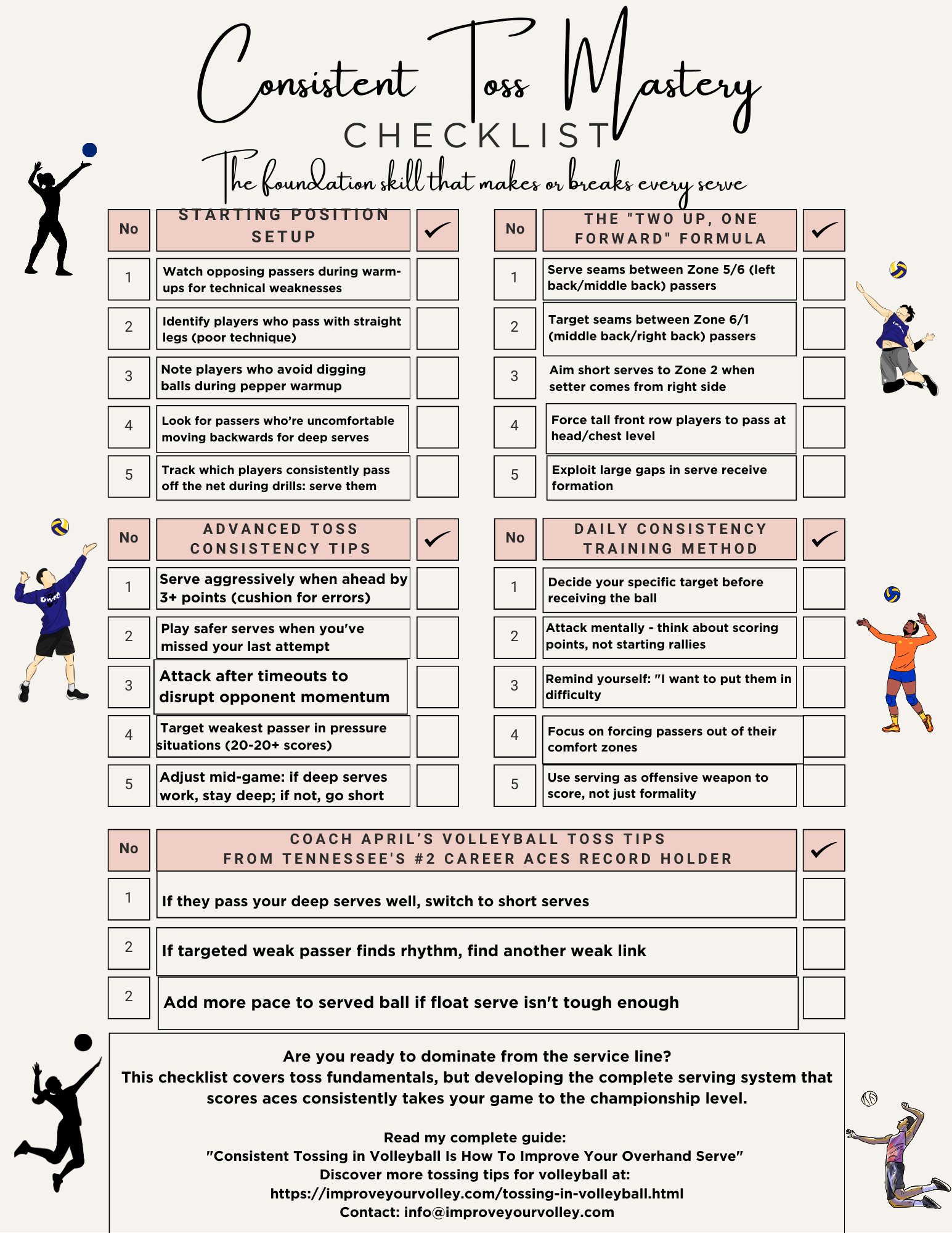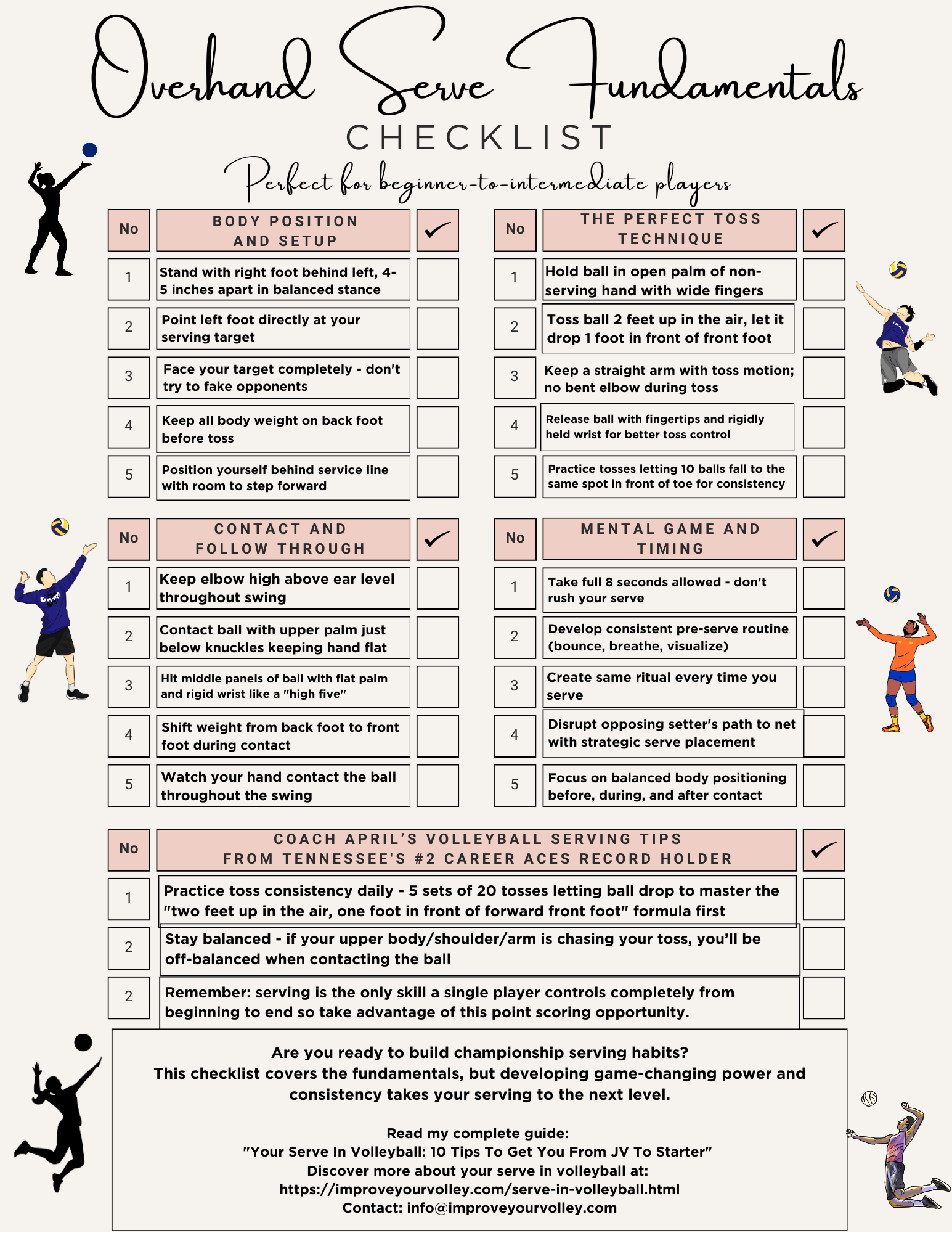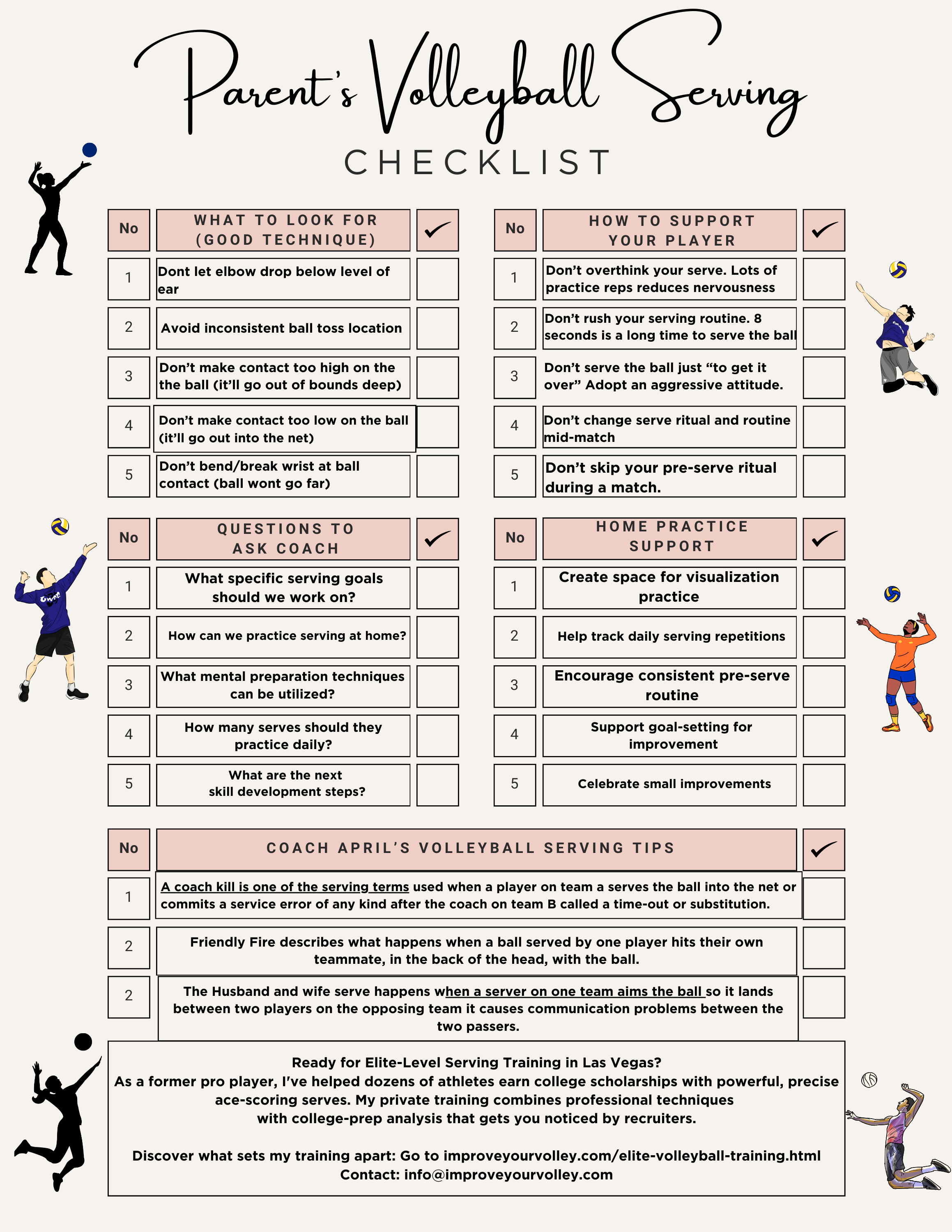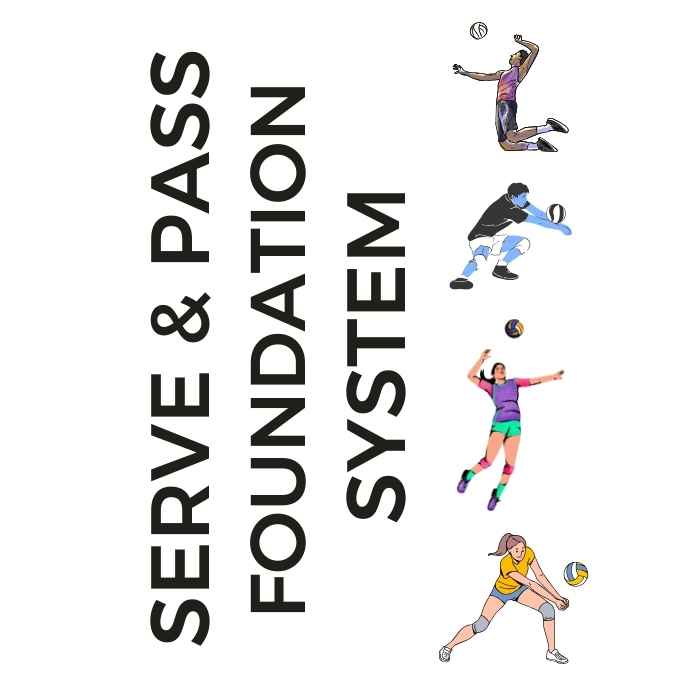
Serve + Pass Foundation System: The Complete Skills Arsenal The two-skill mastery system that transforms inconsistent players into the athletes coaches build their lineups around. Stop Struggling With The Two Most Important Skills In Volleyball!
Volleyball Serving Tips and Strategies To Create Powerful Serves
Learn these volleyball serving tips that explain how a short overhand serve to the front row positions on the court can create a problem for the opposing team.
Learning how to deliver a powerful and strategic serve in volleyball can really boost your stats and increase your playing time in a game.
Are you a tough volleyball server?
As a tough volleyball server, your job is to be comfortable serving anywhere and anyone from behind the service line with pace and precision in order to score points.
When you do your volleyball drills for serving practice you want to do tons of reps to every single one of the six positions on the court.
You want to be able to hit those targets from anywhere behind the service line.
Targets to aim for during your volleyball drills for serving:
-serve seams
-serves the sidelines
serve outside hitters deep in the court
Some players think that being a tough volleyball server means you need to really be sneaky and try and fake out the serve receive by not showing where you are going to serve.
On the contrary I say...let everybody know where you are going to serve.
Face Your Target.
Learning to consistently do the right serving techniques and understanding where to place the ball on the court can create troubles for the opposing team and that's what you want to be known for.
Addi during our private training sessions puts in 100 reps to improve her technique for her floater in volleyball serve on Super Bowl Sunday.
Here are some valuable volleyball serving tips and strategies that can help you elevate your volleyball serving game, regardless of whether the opposing team has their front row in serve receive.
Ready to take your serving to the next level?
I help college-prep servers who've read every tip online but still struggle under pressure ...master next-level serving consistency without mental breakdowns through my proven techniques that make clutch serving feel automatic.
My private training sessions are specifically designed for college-bound athletes who refuse to settle for "good enough" serving.
Limited spots available for serious players only.
Volleyball Serving Strategies and Tactics
Serving to Weak Zones
Before setting yourself up behind the service line to get ready to aim your serve to a specific target, take the time to look for or to remember the opposing team's weaknesses.
Are there specific areas on their court where they struggle with a specifically placed serve?
Toni is working on serving short to zones three and four against three passers on the opposing court.
When you serve, its good to keep mental notes (in your head) of where players on teams have struggled in their serve receive patterns when the teammate or two before you...made a serve to a specific spot or to a specific player that caused the opposing team a lot of trouble.
Plan to exploit these weak zones with your serves.
For example some passers pass better on the left side of the court and not from the right side.
Or some passers move forward well to get to and pass well your team's short serves but its hard for that same player to move backwards to get deep serves in the court.
Want to hear one more and this si for advanced players and servers...who serve a ton of balls in practice that they can pinpoint extremely specific targets...I do this in private training sessions...
There are many players who only pass well from the left side of their body and if you serve their right side..they can't adjust their passing platform fast enough..so they end up passing a ball that's not to the target, shanking the ball or passing a ball that makes it easy for your blockers to anticipate where the setter is going to set the ball so they can get set up early.
That's an advanced passing tip.
But you see how much you can use your serve to your advantage and score points?
You don't have to believe me but numbers don't lie and the numbers below prove my point.
That's why I still have at my alma mater, the University of Tennessee Knoxville
the #2 spot for ALL TIME Season Aces Record and the #2 spot for CAREER Aces Record
that after 40 years (not even Olympic gold medalist Kelsey Robinson who attended UTK for two years before transferring to Nebraska) could break that record .. because I learned early in my collegiate career
- how to serve smart well-paced serves
- how to identify the weaknesses in the passers I was serving...and
- REMEMBERING where and how they made their passing mistakes throughout the whole game.
This serving strategy puts the opposing team in a challenging position right from the start, making it hard for them to easily do the usual "pass-set-hit combination of skills" in order for them to easily run their offense.
A tough serve to an opposing team's weak spot forces the setter to work harder to give a good set to a hitter. If they give a bad set or an "out-of-system" set which means you force them in a position to give you a very easy ball so now your team can run your offense easily in an effort to score a point.
Volleyball Serving Tips
Overhand Serve To Zone Three and Four
A well-executed short serve can cause a lot of problems for the opposing team, especially if the team has taller players in the front row.
So, instead of serving deep in the opposing team's court, try aiming your serve to make it fall short in the opposing team's court within or near the ten foot line.
Many players just happen to serve short in the opposing team's court by accident but elite and experienced players practice a lot of serving reps so that they can serve short on purpose.
Volleyball Serving Tips
Varying Your Serves
This is just unfair. Simone Lee up to 10 kills on 13 attacks and a ridiculous .769 hitting percentage pic.twitter.com/Kb5O4K9OwN
— Tyler King (@King_TylerB) December 8, 2017
The team on the left is the serving team on defense while the team on the right is in serve receive.
Once they "receive the serve" they will run their offense in an attempt to score a point against the defensive team.
Why should you work on mixing up your serves?
By using different types of serves in volleyball and learning how and where to consistently place your serve in the opposing team's court in order to keep their players who are passing in serve receive off balance...you help to prevent them from successfully running their offense.
Volleyball Serving Tips:
The Effects of Short Serves on a Hitter's Spike Approach
What Happens To A Hitter's Spike Approach When You Serve Them A Short Serve?
Like airplanes, tall players usually need longer runways to make a strong three step or four step spike approach which helps them gather speed and momentum before jumping high and reaching as high as possible to contact the ball as far above the net as possible before hitting the ball into the court.
A longer runway helps a hitter keep the ball in front of them which allows them to see the opposing team's court while in the air hitting.
If their "runway" is cut short, in other words if the area where they usually make their long three-step or four-step spike approach is shortened, then that "airplane" (or tall player in the front row in this case) has a hard time taking off.
So as the player serving the ball, you need to "cut" or shorten the opposing hitter's runway way take off ramp.
Serving the ball short to the players in the front row is one of the sneakiest overhand serve tactics to use because it can often prevent them from having the time to back up and take their usual long three or four step spike approach.
Addi getting 100 overhand serve reps in on Super Bowl Sunday working on her standing float serve down the line.
Focusing on starting with hips open to the wall to her right, a consistent toss and a smooth arm swing when contacting the ball with the middle of her hand to the middle of the ball.
Listen to what I tell Addi about being aggressive with her armswing.
Working on her floater in volleyball serve today we did 100 reps of the same serve to the same spot so we could problem solve and work on every body part movement...where things go so when its time to do everything faster...we have smoothed out and understood all the possible wrinkles.
If they do get the set, after they passed the short serve they won't have much time or as much power to hit as hard or as high as they normally would if they weren't passing.
By serving the ball short, you have effectively helped your team by taking one of the opposing team’s front row players out of their offense.
Remember, it doesn't matter how tall you are when serving; what matters is the accuracy of your serve.
You just have to serve the ball 50 times to each of the front row positions--left front, middle front and right front, before or after practice so when the pressure is on, you are ready.
Ready to take your serving to the next level?
I help varsity servers who dominate with float serves add next-level topspin variety without starting over through proven techniques that boost your ace percentage and impress college recruiters...
My private training sessions are specifically designed for college-bound athletes who refuse to settle for "good enough" serving.
Limited spots available for serious players only.
Volleyball Serving Tips
The Overhand Serve To Position 2
The Right Front Zone
Serving to the right front zone, or Zone Two, is particularly advantageous if the opposing team's tall player or setter is in this position.
If the setter is coming towards the net from behind the right front player, a short serve can force the setter to have to face their outside hitter quickly and on the run before setting the ball, increasing the chances that they set their outside players ..off the net ..which means if the hitter hits the ball the hitter would be further off the net....making it easier for the serving team to dig a ball.
If you see that they're playing in Zone Two (RF) look to see if the setter is preparing to come to the net from the right front position, after the ball has been served.
- track the ball that was passed over her left shoulder
- while she is moving towards the net,
- then she is forced to set the volleyball quickly.
Why?
Because she has very little time to adjust her body and square herself to her target to set a ball that has been passed right from the position she just came from.
(Or served right to the position she just came from however you want to look at the situation.).
No matter what, serving the ball to the right front position in the front row gives the opposing team’s setter
- much less time to track the ball,
- stop,
- then set the ball to one of her front row players... especially if she receives an imperfect pass.
If your serves going to the opposing team’s front row, result in an imperfect pass to the setter,
- then she will have an even harder time giving her hitters a good set.
Many times the setter will give her hitters an imperfect set which
- is a ball that she is forced to set off the net or
- to one of her back row players.
If this happens then the hitter ends up spiking a ball that is easier for your team to dig up in defense and this scenario is all due to you using one of these smart short serve tactics.
So the next time that you do overhand serve in practice, make sure you set goals for yourself to make your serves count for points.
Reading Opponent's Positioning
Understanding the positioning of the opposing team's players is critical for deciding where to aim your serve. By analyzing their arrangement, you can make strategic serving decisions that create problems for their serve reception.
Practice these volleyball serving tips to make your serves count for points in your games.
Whether it's delivering a short serve to the front row of the opposing team's court or mixing up your serves to other short zones each one of these strategic moves can make a difference.
Remember, the key is to be as unpredictable as possible, and constantly work on improving the accuracy of your serves.
Ready to take your serving to the next level?
I help varsity athletes who rely on power serves add next-level strategic serving without sacrificing their ace count through proven techniques that showcase elite serving IQ on recruitment videos.
My private training sessions are specifically designed for college-bound athletes who refuse to settle for "good enough" serving.
Limited spots available for serious players only.
Do You Follow Me on Pinterest?
Follow me on Pinterest Volleybragswag to improve your game even faster!
I share alot of individual, partner and easy-to-do volleyball serving drills we do in class with my followers.
Many of these volleyball practice drills you can do at home by yourself or try at your next practice with your teammates.
If you're a B team or JV player trying to make varsity next year...your goal should be to complete 1000 reps a day of at least three of the basic skills on your own...volleyball passing, serving and setting should be at the top of the list.
Meet Tatoo the Tiger, Serving Specialist on VolleyBragSwag's All Beast Team
If your athlete struggles with consistent serve receive, gets subbed out, or is overlooked for playing time—this is the fix you’ve been looking for.

Struggling with passing consistency?
I help talented passers tired of getting pulled from games because of inconsistent serve receive skills BUILD passing confidence without expensive private lessons using the same 3-step system that's helped dozens of my athletes get recruited.
Download my eBook for $17.99 and start building the passing confidence that keeps you on the court—and gets you seen by college coaches.
From Lady Vol to Legend: Coach April Produces Powerful Passionate Players...is that you?
What Are You Looking For?
Click to Download Your Pre Serving Ritual Mastery Checklist pdf:
🎯Volleyball Pre Serving Ritual Guide -
Players! Learn How To Transform Your Serve from Weak to Weapon
Click to Download Your Parent's Volleyball Serving Checklist pdf
🎯Parent's Volleyball Serving Checklist Guide
Parents! Help Your Player Develop Championship Serves (Even If You've Never Played)

Hi there!
Thanks for stopping by. Hope you learned something today that will help you reach your volleyball goals.
Be sure to subscribe to my email newsletter so you can learn more each week!
Stay strong! Stay motivated!
-Coach April

SUSCRIBE to my email newsletter below!
 Click to learn more about the weekly volleyball classes and clinics or email info@imrpoveyourvolley.com for information
Click to learn more about the weekly volleyball classes and clinics or email info@imrpoveyourvolley.com for informationCongratulations to my seven Boys-18s Vegas Volley club players who played in two state championship finals yesterday, the 3A and 5A State champinship finals at Sunrise Mountain High School.
TOURNAMENT CHAMPIONS!
A-1 Vegas Volley VBC
In It To Win It Tournament
May 2 - 4, 2025 Tournament
Gold Medalists
18s Premier Division
Vegas Volleyball's Unsung Heroes: Celebrating Moms with Peace Love Volleyball Shirts
Ready to energize your volleyball mom journey?
Subscribe to my 'Producing Powerful Passionate Peaceful Players' email list above on ImproveYourVolley.com.
You'll receive energy-boosting tips, exclusive insights from me, Coach April Chapple on maintaining momentum in volleyball.
Let's power up the Vegas volleyball scene together!
Recent Articles
-
5 Essential Serving Tips from Tennessee's #2 Career Aces Record Holder
Dec 09, 25 11:39 PM
I've identified the 5 essential serving tips that separate confident servers from struggling ones and you'll serve with the confidence that creates aces -
The Volleyball Toss How Consistent Is Your Ball Toss Before You Serve?
Dec 07, 25 12:29 AM
The volleyball toss for the overhand serve needs to consistently be two feet up in the air and one foot in front of front foot which puts the ball in front of your serving arm. -
Shop Small: Real Volleyball Training With + Results From A Real Coach
Dec 03, 25 10:30 AM
Support a woman-owned business. Get training from a former elite pro with 13+ years coaching experience. Ditch the big box store--invest in proven results.

